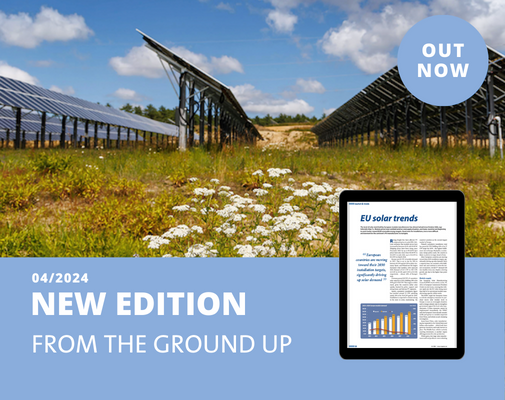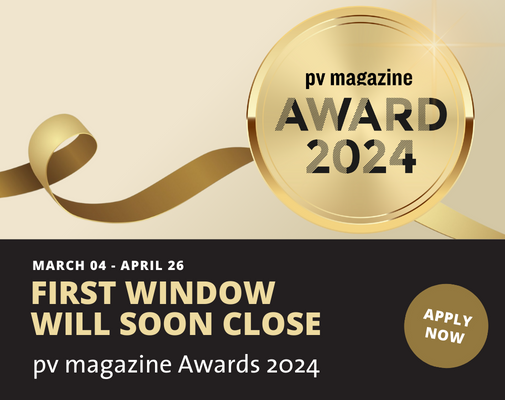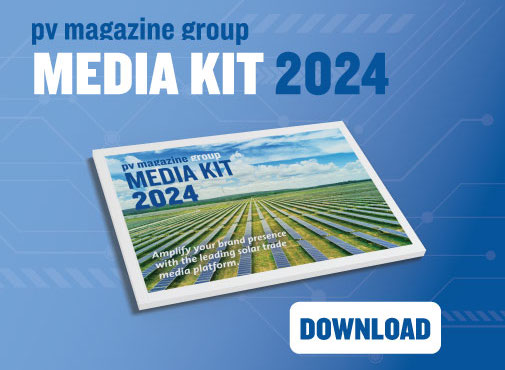Top News
Pexapark records 9.8% jump in European PPA prices for March
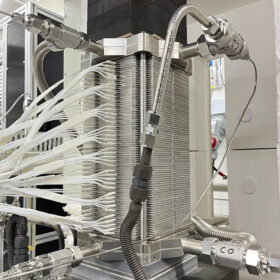
Korean researchers build 8 kW solid oxide electrolysis cell that can produce 5.7 kg of hydrogen per day
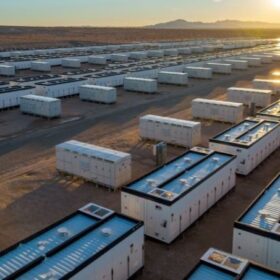
IEA calls for sixfold expansion of global energy storage capacity
pv magazine Webinar
pv magazine Webinar
MEDIA KIT 2024
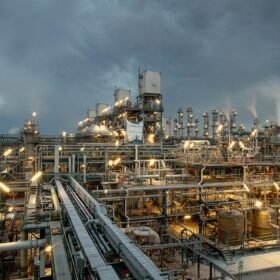
OCI increases production capacity at Malaysian polysilicon factory
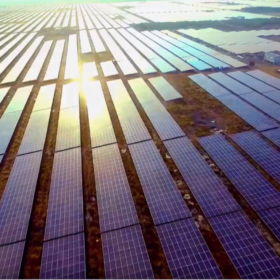
India’s new solar installations hit 6.2 GW in March
Perovskite PV cell, module manufacturing may face material supply risks
Solar-assisted thermochemical heat pump based on caustic soda, water
Vena Energy energizes 125 MW of solar in Australia
Press Releases
REEFLEX: Empowering Tomorrow’s Energy Landscape – A Year of Innovation and Growth
Sonnedix begins construction of its largest UK solar PV plant, providing 100 green jobs to local area
Better Energy more than doubled green energy production in 2023
Giga Storage announces Giraffe Energy Storage Project
Opinion & Analysis
Featured
Chinese wafer prices stable-to-soft amid high inventories
The fastest energy change in history still underway
In 2023, solar photovoltaics and wind comprised about 80% of global net generation capacity additions. Four times as much new solar and wind electricity generation capacity was installed in 2023 as compared with all other electricity sources combined.
At least 29 countries installed more than 1 GW of PV in 2023
IEA PVPS has published its new “Snapshot of Global PV Markets 2024” report, highlighting key insights and trends. Despite record installations, concerns over profitability and manufacturing dynamics persist, underscoring the need for strategic interventions and policy support to navigate towards a resilient and sustainable PV ecosystem.
When nano- meets climate technology
The use of metal-organic frameworks (MOFs) to create nanoscale crystal structures to attract hydrogen molecules could drastically improve the energy efficiency of storing and transporting the energy carrier.
Solar module prices hovering at all-time lows
As solar module prices continue to fall, pvXchange.com founder Martin Schachinger explains how price pressure could increase in the weeks and months to come.
Dust and cloud impact solar across Arabian Peninsula
In a new weekly update for pv magazine, Solcast, a DNV company, reports that dust storms and slear skies led to contrasting March Solar Performance in West Asia. The Arabian Peninsula experienced humid winds and dust storms that reduced solar irradiance to 90% of typical levels for the month.
Markets & Policy
Featured
US to upgrade power transmission infrastructure
European Parliament votes in favor of Net-Zero Industry Act
The European Parliament has approved the Net-Zero Industry Act, which now awaits formal adoption by the European Council to become law. The European Solar Manufacturing Council has welcomed the decision, saying that it “gives a green light for procurement of sustainable European-made solar panels.”
Ireland introduces home energy loan scheme
The Irish authorities have presented a new plan to allow homeowners to borrow between €5,000 ($5,350) and €75,000 for up to 10 years, with low interest rates. Heat pumps, solar electricity and solar water heater installations are all eligible under the scheme.
Greek developer seeks consultants for Egypt-Greece interconnection studies
Greek renewables developer Elica SA is seeking consultants for two desktop studies related to an electrical interconnection project between Greece and Egypt. The undersea link will transmit green energy to Europe via a 3 GW HDVC connection.
Solar key to easing Burundi’s severe energy crisis
Burundi, the poorest country on earth, is unable to buy fossil fuels on theinternational market due to a lack of hard currency. pv magazine spoke with the United Nations Development Programme (UNDP) and a PV analyst to assess the true potential of PV in the nation’s current energy crisis.
Reducing photovoltaic-thermal module temperature with iron, copper oxide
An international research team has proposed using iron oxide and copper oxide to lower photovoltaic-thermal (PVT) solar module temperature. Their analysis showed that the two compounds were able to lower the panels’ operating temperature by 23.49% and 34.58% respectively.
Installations
Featured
Chemitek offers new cleaning products for floating PV
TotalEnergies builds 12 MW solar carport at New York’s JFK Airport
French energy giant TotalEnergies has started building an onsite solar-plus-storage system at John F. Kennedy International Airport in New York City. It will provide energy to the Port Authority of New York and New Jersey and Con Edison, as well as community solar for area residents.
Norwegian startup unveils CO2 water-to-water heat pump
Tequs said its new plug-and-play heat pump can deliver up to 90 C of heat for space heating, air conditioning, and domestic hot water. The new product is available in eight versions with capacity ranging from 17 kW to 268 kW.
Huasun presents ‘zero busbar’ heterojunction solar modules with 23.8% efficiency
The Chinese manufacturer launched two new module series for utility scale applications. The new products feature a temperature coefficient of -0.24% per C and a bifaciality factor of over 85%.
Solarge plans 500 MW BIPV module factory
Dutch module manufacturer Solarge has raised €3 million venture capital from new and existing investors to expand its recently opened facility where it produces lightweight, low carbon, panels for commercial and industrial rooftops.
SunPower to close business units, cut about 26% of workforce
The US-based company announced plans to wind down its residential solar installation locations and close its direct sales unit.
Technology
Featured
Improving solar panel recyclability with lasers
First silicon solar cell celebrates 70th birthday
On April 25, 1954, US researchers presented the first prototype of a usable solar module. The efficiency at that time was around 6%. A lot has happened since then.
PV module fault detection technique based on convolutional neural network
An international research team has used the convolutional neural network (CNN) deep learning algorithm to identify faults in solar panels. Its work showed the proposed technique has a high degree of accuracy, especially if combined with transfer learning models.
Sodium-ion battery could charge in several seconds
Researchers at the Korea Advanced Institute of Science and Technology (KAIST) have identified a high-energy, high-power hybrid sodium-ion battery capable of charging in just a few seconds. The system integrates anode materials typically used in batteries with cathodes suitable for supercapacitors.
Indian startup develops sand-based gravity energy storage system
Baud Resources, a clean-tech startup, has developed a gravity energy storage mechanism that uses locally available materials such as sand and industrial waste as its payload. The company is building a 100 MWh pilot plant that will reportedly offer a levelized cost of storage of around INR 2.5 ($0.03)/kWh.
South Korea offers support for agrivoltaics
The South Korean government has announced a new package of measures to support agrivoltaic projects. It says that the agrivoltaics business should be a priority for agricultural companies.
Manufacturing
Featured
JinkoSolar posts $1 billion net profit for 2023
DualSun launches foldable plug-and-play solar kits
France’s DualSun has developed foldable plug-and-play solar kits with a power range of 420 W to 1.68 kW.
GameChange Solar, JZNEE to build 3 GW tracker factory in Saudi Arabia
GameChange Solar, a US-based tracker supplier, has announced the construction of a 3 GW tracker factory in Saudi Arabia, with plans for potential expansion to 5 GW in the future.
NREL updates interactive chart of solar cell efficiency
The US National Renewable Energy Laboratory (NREL) has updated its research cell efficiency chart for a range of PV technologies.
French module makers request permits to build GW-scale panel factories
Carbon and Holosolis have both requested construction permits for 5 GW solar panel factories in France.
Kaco launches new inverters for complex roof architectures
The new products are intended for applications in commercial and industrial PV projects. The devices feature an efficiency rating of up to 98.1% and a European efficiency of up to 97.8%.
Energy Storage
Featured
AfDB identifies key priorities for minigrid deployment in Africa
Battery makers oversubscribe India’s latest 10 GWh tender
The Indian authorities say the nation’s latest 10 GWh tender was oversubscribed. It attracted seven bidders, including ACME Cleantech Solutions, Reliance Industries, and Waaree Energies.
Australia announces community battery rollout
The Australian federal government’s initiative to install 400 community batteries across the nation has reached the Australian Capital Territory, with plans for three new battery energy storage systems.
Solar-assisted heat pumps vs. air-source heat pumps
A group of researchers in Iran has analyzed the coefficient of performance and the energy consumption of a solar-assisted heat pumps and an air-source heat pumps and has found that three factors are crucial to determine their annual performance – irradiance changes, ambient temperature, and wind speed.
Spain launches 1.3 GW synchronous renewables, storage tender
The Spanish authorities are seeking 1.3 GW of clean energy and storage projects to provide flexibility, stability and security to the national electricity supply.
Anker Solis launches residential batteries
The new X1 can operate inside or out, from -20 C F to 55 delivering what Anker says is 100% power output without derating. The batteries are lithium iron phosphate (LiFePO4) and will reportedly remain fully operational for up to 3,000 charge cycles.
